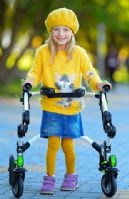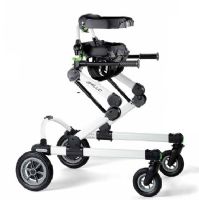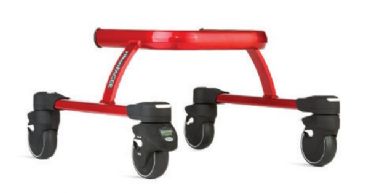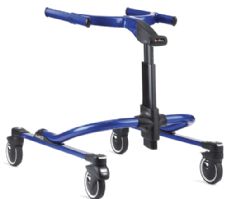 Written by Mike Price, OT
Written by Mike Price, OT
Providing special needs children with the ability to independently mobilize is important and luckily, there are many types of equipment that will achieve this goal; gait trainers are one of them! This guide will tell you everything you need to know about pediatric gait trainers and will recommend best-selling products along the way.
A gait trainer is a mobility aid that stabilizes and supports users as they walk, and is specifically designed for non-weight bearing or partial weight bearing users. They are sometimes referred to as adaptive walkers or gait trainer walkers.
Gait trainers can assist people of all ages, but they are most commonly used by children. They can be utilized by users who are living with either temporary or permanent mobility impairments. Gait trainers are useful for various congenital and developmental conditions, such as spina bifida and cerebral palsy, along with physical defects or injuries that impair ambulation (unassisted walking).
Although they may appear to be similar to the untrained eye, a gait trainer differs from a walker in that it offers more balance assistance and weight-bearing support. Walkers are generally indicated for users with the ability to bear their weight fully through their legs, providing a lower level of support while the user walks. Gait trainers are utilized by users who cannot bear their weight through their legs or can only do so partially, including a wide range of engineering features that provide specialized support.
A walker that has more ad-ons (that offer support) technically is a gait trainer. The ad-ons can be a seat, forearm supports, harness, hip positioners, etc.
Gait trainers designed for children come in several different formats so that each child’s unique needs and requirements can be addressed. The main gait trainer styles include anterior, posterior, and suspension.
 | Ormesa Grillo Anterior Special Needs Gait Trainer - 4 Sizes View Product |
An anterior gait trainer is placed in front of the child for support. Users push the gait trainer forward, dispersing their weight ahead through their arms. Also known as traditional gait trainers, anterior styles are frequently used by children who need to lean forward so they can propel themselves, but who also need balancing support. They’re perfect for kids who do not have good postural control or the functional gait skills necessary to safely use a walker.
 | Ormesa Grillo Posterior Special Needs Gait Trainer View Product |
A posterior gait trainer is placed behind the child for support. Users place their hands on each side, pushing their weight down through their arms as they pull the gait trainer behind them. Also known as reverse gait trainers, posterior walkers may take a bit of a learning curve to master, but they are generally preferred over anterior gait trainers as users progress in their walking training. Research has demonstrated that posterior gait trainers optimize step length, single support time, and double support time over anterior styles, while they also offer more advantages in terms of energy conservation and upright positioning. They’re ideal for children living with various permanent movement disorders as well as kids recovering from an injury, illness, or post-surgery.
| Kaye Suspension Gait Trainer Walker View Product |
Also known as suspension walkers or full gait trainers, suspension gait trainers use a harness system to support the user as they walk and stand. Often configured with a multi-positional seat or saddle for resting, suspension gait trainers also often feature winches to lift the user into a standing position. They provide full support for users who cannot bear their own weight through their legs and are frequently used for rehab following an injury, or for learning/re-learning how to walk. Some suspension gait trainers are used in conjunction with treadmills for physical therapy, along with providing support for everyday walking assistance. Many suspension gait trainer designs can function as both a posterior and anterior gait trainer for convenient versatility.
Specialized designs include gait trainers created specifically for toddlers, outdoor use, and those with customizable support.
 | Rifton K610 Mini Pacer Gait Trainer View Product |
If your child is not walking unassisted by the age of 2 or 3, gait trainers specifically designed for very young children can help tremendously. Gait trainers configured for toddlers are smaller and easier to maneuver and can come in both anterior and posterior formats. They help ambulatory children to optimize stride, alignment, step length, cadence, and leg muscle strength, while they also help non-ambulatory kids to achieve gross motor goals with walking, such as balance, coordination, endurance, strength, and posture. Because early upright mobility is crucial for healthy body function, it should be encouraged with toddlers who are not walking on their own for whatever reason. Brightly colored and wheeled gait trainers can help engage youngsters, providing fun, enjoyable support they’ll WANT to use!
 | Rifton Pacer Gait Trainers in Medium and Large View Product |
Many gait trainers for children include a range of both standard and add-on options that enable you to customize their use to meet your child’s specific special needs. Maximizing stabilization, this diverse array of specific supports for the ankles, forearms, pelvis/hips, and trunk assist children in practicing safe and posturally correct walking. The brain’s neuroplasticity allows children with limited mobility or brain damage to achieve motor skill development gains with locomotor training, or activity-based therapy and movement. Even if the child never regains or attains the ability to walk independently, using a gait trainer with specialized supports can help in other ways. Aside from preventing the long-term health complications of immobility, using a gait trainer helps foster self-confidence, a better sense of independence, and increases eye-to-eye social interaction with peers.
| Miniwalk I and Miniwalk II Gait Trainers View Product |
Gait trainers that are used outside are constructed with materials that won’t rust or corrode, ensuring that they’ll still maintain functionality in any weather. They’re also designed to move smoothly over roads, curbs, and rough, uneven terrain, often using larger wheels to accommodate different surfaces. If your child will be using a gait trainer outside, be sure to choose a model specifically designed for outdoor use. Most outdoor gait trainers can also be used indoors for convenient versatility.
Determining your child’s unique requirements will help you select a pediatric gait trainer that can meet these special needs. Figuring out the right size (which we cover in more depth a little further on in this article), where the gait trainer will be used (i.e., school, home, therapy, or outdoors) and what kinds of supports will be needed to accommodate different needs are all important points to consider before you can choose the best gait trainer for your child. Here are some of the more common features to look for:
Helping to prevent the crossing of the legs or scissoring, ankle prompts attach to the bottom of the gait trainer frame and can be adjusted in length for customized foot separation. Padded for comfort, they may have spring adjusters to control stride placement and limit stride length. When they’re used in conjunction with thigh prompts, ankle prompts also assist with leg abduction.
Encouraging a forward-leaning posture, arm prompts are used on anterior gait trainers. They are often adjustable in angle, height, lateral proximity, rotation, and forward/backward movement, accommodating numerous positioning needs.
Most gait trainers come with a braking system or offer an option for brakes. Helping to slow or stop movement safely, they’re almost always in a hand-brake format, located near the hand grips or arm prompts to ensure easy accessibility for children.
Also known as trunk positioners, chest prompts hold the child’s torso at the desired angle. They’re adjustable in tilt angle backward and forward and help to keep the trunk in a healthy, upright position. Chest prompts add stability for children as they walk with the gait trainer.
Specially designed for users who are unable to bear their weight down through their arms and hands, forearm supports are used on both posterior and anterior gait trainers. Also known as arm platforms, forearm supports optimize user comfort and help keep the arms in posturally correct positions.
Also referred to as handgrips, handholds come in a variety of styles, including ergonomic, padded, and adjustable. Utilized by both the child and the caregiver, handholds can be placed anywhere along the top bar of the frame and are usually positionable in every direction.
Specifically designed to promote proper positioning for gait training, hip positioners facilitate lower extremity weight shifting, natural pelvic movement, and good abduction. Pads are sometimes included to optimize user comfort.
Frequently used on suspension or full gait trainers, a multi-positional saddle (MPS) allows for more finely tuned positioning of the pelvis. Usually adjustable in angle to position the pelvis in either posterior or anterior tilt for the most effective gait pattern, the MPS also tends to be adjustable in-depth for optimal positioning of the pelvis in relation to the upper body, facilitating forward motion during ambulation.
Also known as pelvic positioners, pelvic supports are a great choice for children who need less abduction. As a softer alternative to hip positioners, pelvic supports assist with weight-bearing and freedom of movement, keeping the child in a posturally correct position. Flexible, dynamic pelvic supports are especially helpful for children with hypotonia or dystonia, promoting the movement of the pelvis and rotation of the trunk.
Swinging along with the child’s stride, thigh prompts help to prevent leg scissoring (crossed legs), especially when they're combined with ankle prompts. Often height-adjustable in the lateral and medial positions, thigh prompts help to prevent the child from turning within the gait trainer frame. They also assist with leg abduction.
Another important aspect to consider when you’re choosing a gait trainer for your child is the weight and foldability of the equipment. If it’s too heavy, the child won’t be able to maneuver it. Collapsible, lightweight gait trainers are also easier to transport in vehicles, buses, and airplanes.
Gait trainers are used by children who are not able to consistently bear their full weight through their legs. They’re often utilized to address pre-ambulatory skill development, helping children build postural stability and strength, improving alternating and reciprocal leg movements for stepping, along with enhancing endurance. They’re frequently used by children following an injury or surgery for walking rehab, or for learning how to walk. Gait trainers are also used by children living with medical conditions like cerebral palsy, spina bifida, and other long-term issues that impair mobility, providing them with a safer way to move about their world and interact with peers.
Usually combined with walkers under Medicare guidelines, gait trainers are listed as durable medical equipment under Medicare Part B, but they must be considered medically necessary. They must also be prescribed by a physician. The Healthcare Common Procedure code lists a specific E8001 Medicare code for pediatric gait trainers, but they caution that the equipment may not be covered by Medicare, as they’re deemed a service not separately priced by Part B. Add-on options like forearm supports and hip positioners may be billed separately if the feature is similar to walker accessory codes. Be sure to consult with your child’s physician to see how the Medicare billing guidelines apply to your particular situation.
A gait trainer is typically configured as a specially designed frame with wheels, functioning as a support walker, but offering more support and stability for children and adults who are unable to walk independently. The frame may be placed behind the child (posterior), in front of the child (anterior), or all around the child (suspension), providing unweighted support and postural alignment to practice walking. They often come with a range of standard or add-on support options to help children living with more involved immobility to ambulate safely.
Determining your child’s needs is the first step to choosing the best gait trainer, along with consulting with your child’s doctor or physical therapist. An anterior pediatric gait trainer is generally a good choice for children recovering from a temporary injury or condition. It can also help as the initial gait trainer before progressing to an anterior gait trainer or rolling walker as functional gains are made. Posterior gait trainers inspire more upright positioning and are often preferred by children as their daily mobility aid once they learn how to use them. Suspension gait trainers are often used for therapy along with their use at home for children with more physical challenges, either short or long-term.
Gait trainers help people learn or re-learn how to walk, while they’re also employed as daily mobility aids for users with long-term medical conditions, providing stability, support, and balance with their wheeled frames. It provides children unable to bear their weight a source of independent mobility, inspiring a greater interest in exploring their environment and the opportunity for eye-to-eye peer interaction. Upright walking helps to keep young bodies healthy, improving bowel and bladder function, prevention of contractures, increasing lung function, optimizing visual awareness, enhancing strength, boosting bone mineral density, and increasing psychological and cognitive development.
Rifton is a popular manufacturing brand that makes all kinds of mobility equipment for special needs children and adults, including gait trainers. Their adaptive mobility equipment is designed for a wide range of clients with varying abilities, offering customizable support that is generally much more versatile than its competitors. Considered the gold standard of mobility devices, Rifton offers superior quality and innovative designs that both kids and parents love.
Because choosing the right size gait trainer for your child is crucial for how it performs, it’s important to determine your child’s specific measurements to ensure it fits. Some gait trainers are adjustable in size, growing with your child so you don’t have to keep purchasing new equipment. While most manufacturers include sizing guides for their particular gait trainers on the product information page, the following are the most typical measurements you need to take to choose the right size for your child:
Impacting a child’s posture, balance, and alignment, gait disturbances affect activities from learning to playing, from feeding to dressing, and interaction with peers. While some children develop the ability to walk unassisted through normal developmental stages, other children do not progress through these same levels in a timely manner. Physical disability, developmental delays, and a wide array of neurobiological disabilities can all negatively affect gait and ambulation, as can muscle tone, low fitness, and obesity.
Children who are unable to walk unassisted and bear their weight through their legs need the therapeutic intervention that pediatric gait trainers can provide. Because childhood is the time when your growing youngster will develop most of the basic motor skills they’ll use for the rest of their life, it’s important to provide gait training support early on to ensure the highest, long-lasting benefits that will help them well into adulthood.
Pediatric gait trainers come in a variety of styles with multiple support options to meet specific needs. They can help improve both mental and physical health by helping your child stand and walk upright, which also encourages them to explore their world and interact more with others. Frequently designed with bright colors, their wheeled frame is engaging for children. They often love these devices and have fun with them while they receive exceptional therapeutic benefits at the same time!
We invite you to check out more expert tips for special needs families at our Caregiver University educational resource. It’s chock full of helpful information that can assist you in making the best choices for the loved ones in your care. You can also find more support at our Special Needs catalog.

Co-Founder of Rehabmart and an Occupational Therapist since 1993. Mike has spent his professional career working in multiple areas of Occupational Therapy, including pediatrics, geriatrics, hand therapy, ergonomics and inpatient / outpatient rehabilitation. Mike enjoys writing articles that help people solve complex therapeutic problems and make better product choices.